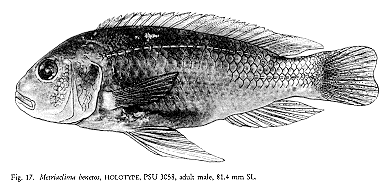

The holotype of Maylandia benetos, an adult male (PSU 3058,
Penn State University) measuring 81.4 mm SL, from Mazinzi Reef
in the southeast arm of Lake Malawi between Monkey Bay and Nkhudzi.
M. benetos is known only from this rocky reef.
This entity has been known informally as Pseudotropheus zebra
"mazinzi" in the aquarium trade and was previously considered
to represent a population of P. zebra (M. zebra) proper
(Konings, 1995).
Together with M. callainos,
M. benetos is distinguished by having a pale blue ground color
without any distinct vertical bars. The authors of this species
(Stauffer et al., 1997) report that females of M. benetos
are "brown with green highlights, while M. callainos females
are either light blue or white." Males of the two forms were not
compared, but breeding males of M. benetos "have a light blue
ground coloration laterally that is darker dorsally and fades to
white ventrally. For the most part, no vertical bars are visible....
Head blue/gray, cheek light blue, white gular [branchiostegal
membrane]. Some larger males in the wild have yellow gulars. Although
rarely seen in wild specimens, alpha males held in aquaria will
sometimes develop a bright yellow gular" (Stauffer et al., 1997: 203).
The same authors report that breeding males of M. callainos
"have a light blue ground coloration with green highlights on dorsal
one-third; head light blue with green highlights dorsally, with white
gular and black opercular spot. Occasionally,
males will be either white or blue/white blotched" (p. 204).
Illustration reproduced from fig. 17 (a photograph retouched by M. Katz) of
Stauffer et al. (1997);
used by permission of Dr. Jay Stauffer.

| Last Update: 16 January 2000
Web Author: M. K. Oliver, Ph.D. Copyright © 1997-2021 by M. K. Oliver, Ph.D. - ALL RIGHTS RESERVED |